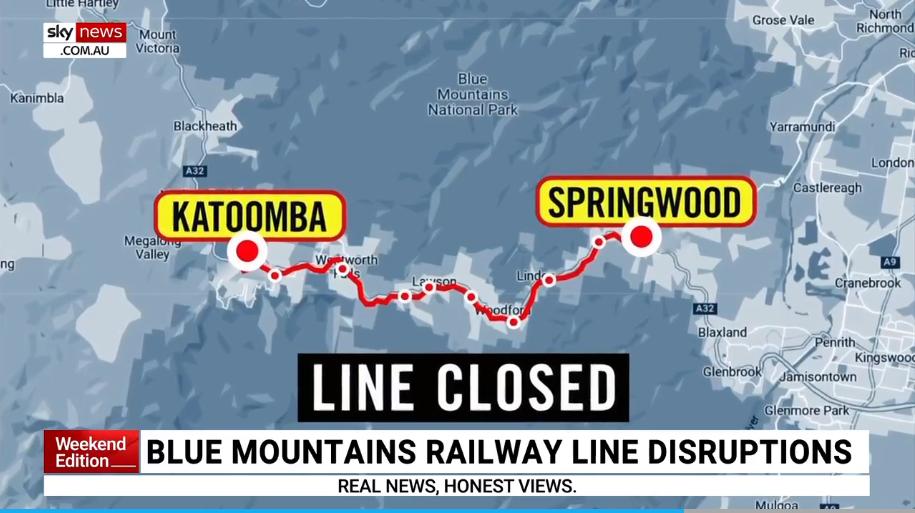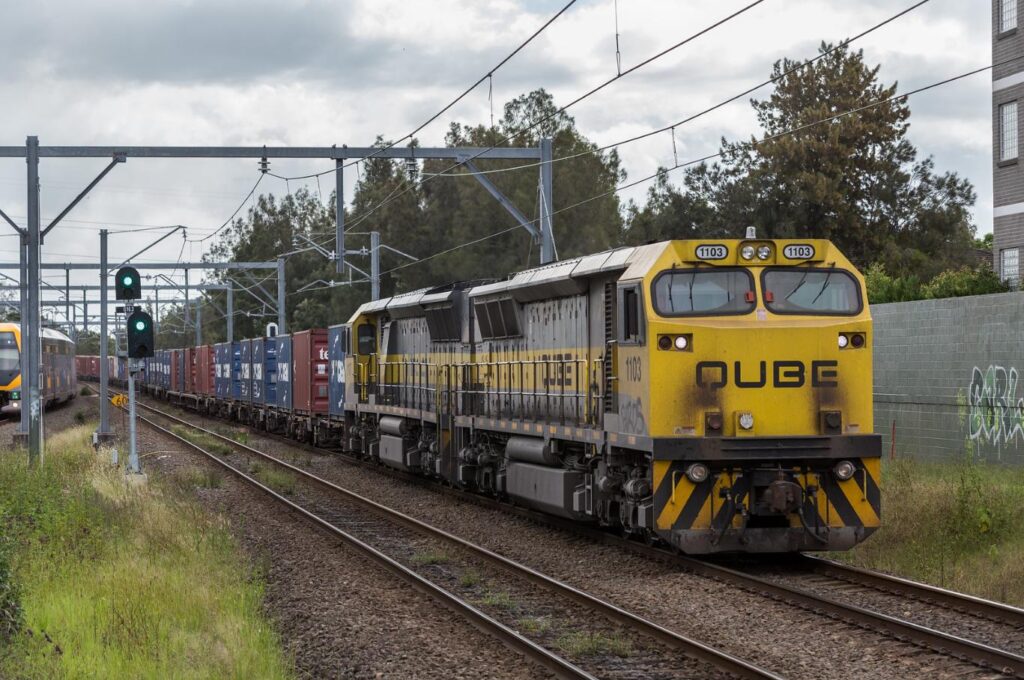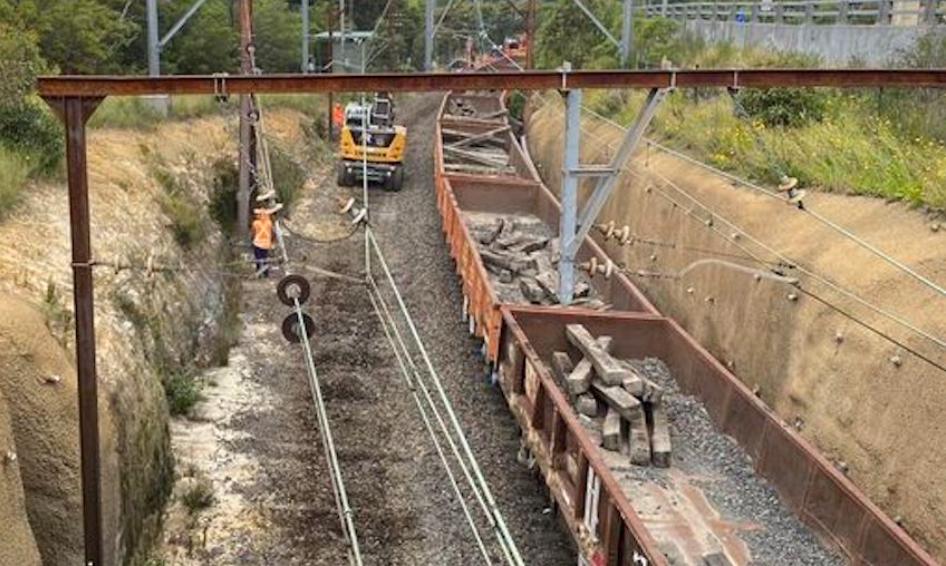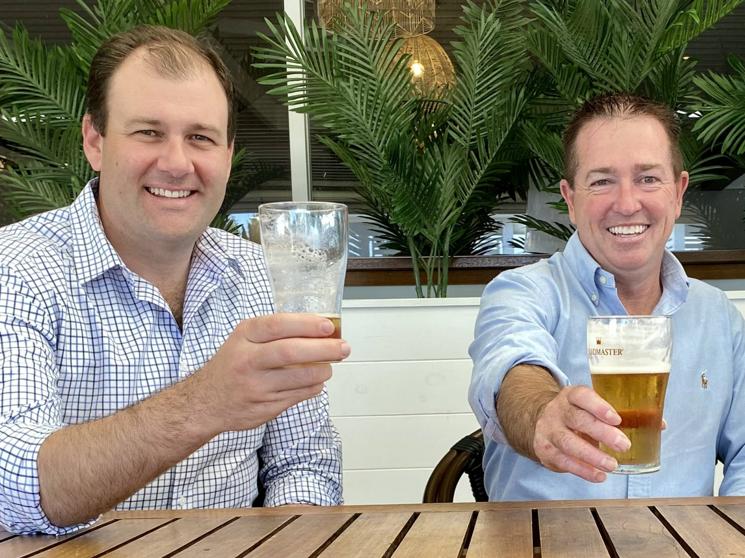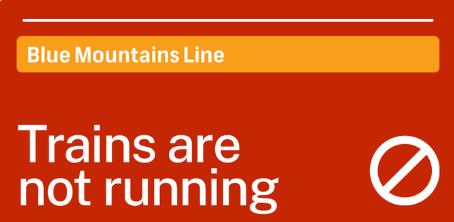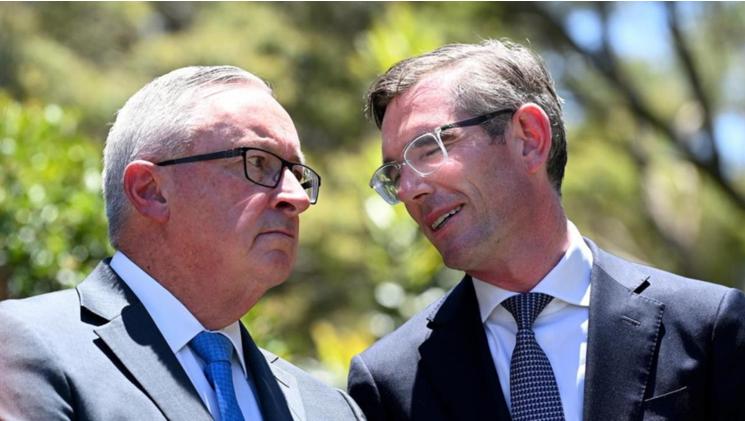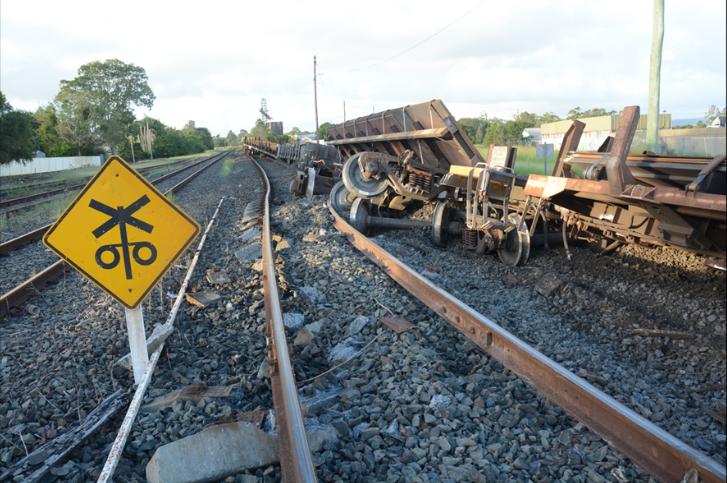QUBE derailment despair disrupts Blue Mountains Christmas tourist season
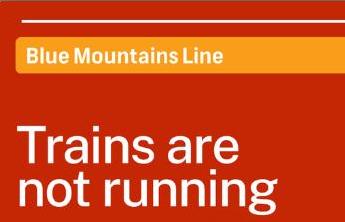
The ‘QUBE’ Trail Derailment at Hazelbrook, eastbound

The actual QUBE ‘8114’ locomotive that derailed due to a single axle on one of its old towing bogie carriages. The derailment occurred around Hazelbrook, but instead of the driver stopping, the derailed bogie dragged for some 10 km crushing every concrete sleeper to Linden, until the train finally came to a halt.
- Why did this train take so long to stop?
- Was the train driver distracted and so why didn’t he notice the thousands of loud bangs as successive railway sleepers being smashed up by the train wheel one after the other?
- How old is this train (the locomotives and each freight carriage including the bogie undercarriages)?
- When was the last time the locomotives (two in tandem shown here), the carriages including the bogie axle assemblies properly inspected and serviced?
- What is the frequency of QYUBE’s maintenance shcedule for its rolling stock including this damaged train?
- What is the total repair cost? This investigation is being led by the NSW Office of Transport Safety Investigations (OTSI). OTSI conducts rail investigations in NSW on behalf of the ATSB under the Transport Safety Investigation Act 2003 (Cwlth). This organisation should know the total cost, and who has paid for it.
- Who pays? Taxpayers? Why not the culprit faulty train bogie owner publicly listed company ‘QUBE Holdings Ltd’? It happened to post a massive multi-million dollar annual profit just last August 2022.
- What is the contract cost for buses to replace trains during the track repair period?

QUBE Holdings Ltd Chief Executive Paul Digney (currently standing). Read More: ^https://qube.com.au/about/board-leadership/
QUBE Holdings Ltd is the re-branded Patrick Stevedores (corporation). QUBE’s Blue Mountains Derailment of Christmas 2022 has since shut down the Blue Mountains railway line in both directions.
“This line is a vital component of our supply chain and we will work closely with industry as crews work hard to get it repaired and reopened. The track in both directions is impacted. It is expected more than 15,000 sleepers will need to be replaced, 120 broken rails fixed, and electrical work undertaken to restore signalling along the entire section of damaged track.
The adjacent undamaged track will remain open to diesel trains until Sunday morning, which will keep goods and commodities moving while final repair plans are being established, and to allow freight operators time to find alternative paths.”
He was “at a loss” when he heard the repairs would continue beyond Christmas. “We had just decided to restart the Explorer Bus daily. We rely on the train service for our customers.”The disruption is “another devastating blow” to the local tourism industry after bushfires, COVID and weather events, “just when the industry was looking forward to a busy Christmas and summer holiday tourism trade”.“Those who rely on the train service are absolutely devastated,” he told the Gazette. One Katoomba cafe told him the train derailment had destroyed their Christmas/New Year tourist trade.”
Buses Replacing Trains…yet again!
- There is NO daily ‘Bullet Train’ Bathurst-Sydney return
- There is NO daily XPT country express train Dubbo-Sydney return
- There is NO weekly luxury Indian Pacific Experience Perth-Sydney return
..until further notice. This must be having a devastating impact on regional travellers to central New South Wales and westward beyond to Perth who have booked on the Indian Pacific Experience train.
Welcome to the Blue Mountains, enjoy your stay, and trips! Not!
We consider that QUBE Holdings Limited be sued by the New South Wales Government for the costly disruptions and loss of tourism revenues caused by this one train axle maintenance oversight. It was not an “accident”. It was a neglect of bogie maintenance.
Sydney-based QUBE Holdings Limited clearly has copious funds to compensate Blue Mountains locals impacted, given QUBE’s most recent August 2022 $220 million reported profit out of $2.5 billion in revenue for the past year.
What more can the Blue Mountains cop to further undermine tourism?
QUBE has disrupted Tourism to the tune of undisclosed hundreds of millions
Pre Gospers Mountain NPWS debacle, Blue Mountains tourism statistics showed that about 4 million people visit the region annually, two thirds on holiday, else a third visiting friends and relatives. About 3 million are day trippers from Sydney (and beyond – interstate and international), and many arrive by train else by private car.
The actual train statistics are not known publicly, probably because no one counts the OPAL stats at Katoomba and Leura stations.
The busiest tourism season for the Blue Mountains is over the Christmas holidays, but from 14 December to likely the end of the summer season, the Blue Mountains Line is closed to Sydney from Springwood.
So how many hundreds of thousands of potential tourists have been denied access to the Blue Mountains this Christmas holiday season?
How much revenue will the Blue Mountains tourism industry lose as a result of this derailment over our annual peak tourist visitation season? Who compensates this loss?
“The Blue Mountains is regionally NSW’s number 7 region for domestic day trip visitors and number 6 for expenditure”.
[Source: Blue Mountains visitor profile Year ending March 2019, from the National and International Visitor Survey, by Tourism Research Australia.]
 Loading...
Loading...
The Blue Mountains have been wall-to-wall attacked by government incompetence and neglect since Gospers Mountain pile burn was lit on 26th October 2019:
- Bushfires (by pile burns, lightning, bush arson, hazard reductions) each either ignored or abandoned by the custodial NSW Parks Service and abusive RFS, just left to become widespread and destroy most of the Blue Mountains World Heritage Area and so denying tourist access
- NSW Berejiklian Government NSW Emergency Services Minister David Elliott abandoning bushfire response in late December 2019 for his European jaunt
- Rolling emergency declarations by the NSW Berejiklian Government mandating all visitation to the Blue Mountains for months
- The federal Morrison Government’s quarantine failures to prevent the ingress of the Chinese Coronavirus pandemic into Australia, then mandating economic lockdowns so denying all visitation to the Blue Mountains for two years (Mar 2020 to Mar 2022)
- NSW Berejiklian Government’s Health Minister Brad Hazzard’s dereliction of duty by allowing 2700 passengers to disembark the foreign cruise ship Ruby Princess 19th March 2020 at Sydney’s Circular Quay before COVID-19 test results were verified, so facilitating a mass spread of Coronavirus into Sydney, NSW and Australia. This despite the ship previously logging 158 cases of illness on an earlier voyage. Some 663 positive cases were later confirmed and 28 died. This was allowed to repeat with the Majestic Princess in which 800 cases disembarked at Circular Quay in Nov 2022. NSW Health Minister? Brad Hazzard.
- Road and rail closures due to landslips impacting the Blue Mountains due to torrential rain events (Feb 2020 – Nov-2022) caused by the perennial La Niña climate pattern, yet Blue Mountains {city} Council’s failure to plan and prepared or employ/engage hydrologists in its town planning function (nor NSW Government in railway infrastructure)
- Blue Mountains {city} Council’s impost of cosmetic pebblecrete footpathing that for more than 6 months denied pedestrian shopper access to many retail business in Katoomba, so sending a number broke
- Months of rail access caused by QUBE goods train derailment due to lack of bogie maintenance.
…it goes on…while our precious Blue Mountains wanes from being once a revered as a prized Nature wilderness destination.
Under government, the Blue Mountains is steadily being swallowed into another ‘mega’ Sydney suburb – dam raising to flood wilderness, 24/7 airline flight paths overhead, rezoning of bushland for sprawl residential.
Postscript:
“This line is a vital component of our supply chain and the NSW Government will work closely with industry as crews work hard to get it repaired and reopened.The track in both directions is impacted. It is expected more than 15,000 sleepers will need to be replaced, 120 broken rails fixed, and electrical work undertaken to restore signalling along the entire section of damaged track.The adjacent undamaged track will remain open to diesel trains until Sunday morning, which will keep goods and commodities moving while final repair plans are being established, and to allow freight operators time to find alternative paths.“We will continue to provide regular updates to the rail freight industry and passengers on progress of the repairs.”
“Due to extensive damage to infrastructure on that section, electric intercity passenger trains cannot travel through there at all until further notice.Buses will replace trains between Katoomba and Springwood with an intercity train operating hourly services between Sydney and Springwood in both directions. Trains will run every 2 hours between Lithgow to Katoomba in both directions. Bathurst services will terminate at Lithgow with buses replacing trains in both directions to Blacktown. Hourly train services will run in both directions between Mount Victoria and Katoomba.From Monday, Dubbo XPT services will be replaced by road coaches in both directions between Sydney and Bathurst. Customers will join rail services from Bathurst for the remainder of their journey. Coach services from Dubbo through to Broken Hill in both directions are still in operation as the Broken Hill Xplorer is not running at present due to flood damage to the track west of Parkes.Where possible NSW TrainLink directly contacts customers on booked regional services to advise of changes.Customers using the Blue Mountains line should expect delays or extended travel times. Customers should plan ahead and check Transportnsw.infolaunch for the latest service details.”
The timing has been peak Christmas holiday visitation season for the Blue Mountains tourism, mainly arriving from Sydney. Nice one.
Yet, we note the absence of any apologies from QUBE or government to rail passengers, to tour businesses in the Blue Mountains and westward: Bathurst, Dubbo, Broken Hill, Perth (the Indian Pacific)?
Recall just nine months prior, the substantial landslip undermining the railway tracks at Leura in 19th March, 2022:
“Commuters urged against travel to the Blue Mountains as roads and train lines face severe damage.New South Wales residents have been warned against travelling to the Blue Mountains this weekend as train lines and roads are damaged due to the past weeks’ intense rainfall.The Blue Mountains train line is among one of the hardest-hit transport infrastructures in the state with repairs expected to take at least a week.Trains cannot run between Penrith and Lithgow due to landslips on the Blue Mountains line at Katoomba and Emu Plains, and a sinkhole at Leura.New South Wales residents have been warned against travelling to the Blue Mountains this weekend as train lines and roads are damaged due to the past weeks’ intense rainfall.The Blue Mountains train line is among one of the hardest-hit transport infrastructures in the state with repairs expected to take at least a week.Trains cannot run between Penrith and Lithgow due to landslips on the Blue Mountains line at Katoomba and Emu Plains, and a sinkhole at Leura.”
Then there was this one (QUBE has form in maintenance neglect)…
‘Derailment involving QUBE freight train 5WB7 Casino, NSW, on 17 March 2022‘
‘An investigation has commenced into the derailment of freight train number 5WB7 at Casino, New South Wales, on 17 March 2022.At about 2230 on 17 March 2022, an axle in the rear part of train 5WB7 broke as the train entered Casino Yard, derailing the wagon. As the train passed through the yard it travelled over a set of points for the closed Murwillumbah Branch (set for the mainline), at which point the derailment worsened with the rear four wagons derailing and becoming detached from the rest of the train.The train then passed through a second set of points (also set for the mainline) and came to a stop. A further four wagons at the rear of the train were derailed. A significant amount of track and signal infrastructure was damaged within Casino Yard, however there were no injuries.This investigation is being led by the NSW Office of Transport Safety Investigations (OTSI). OTSI conducts rail investigations in NSW on behalf of the ATSB under the Transport Safety Investigation Act 2003 (Cwlth). OTSI investigators have begun collecting evidence from involved and other interested parties to determine the factors contributing to the accident.This evidence will include:
- CCTV footage
- data logger information
- recent track inspection and maintenance works
- wagon build and maintenance history
- asset handover process and supporting documentation
- metallurgical analysis of the broken axle.
- A final report will be released at the conclusion of the investigation. However, should a critical safety issue be identified during the course of the investigation, OTSI and the ATSB will immediately notify relevant parties, so that appropriate and timely safety action can be taken.’
SOURCE: New South Wales Rail News, ^https://www.railpage.com.au/news/s/derailment-involving-qube-freight-train-5wb7-casino-nsw-on-17-march-2022
9th January 2023: Blue Mountains line set to re-open
“Our maintenance crews are working around the clock right through the holiday period to get the job done. They have already laid almost 10 kilometres to support the new track, installed more than 15,000 new sleepers, laid more than 11,000 tonnes of ballast and replaced or repaired 39 pieces of signalling equipment.This work has been carried out in extremely difficult terrain and has required detailed planning and specialist engineering expertise to get the crews and replacement material on site to carry out the repair work safely.By working closely with industry, we have been able to keep freight moving across this critical supply chain by opening the adjacent track in blocks of days to diesel trains. I want to thank the community for their patience while crews carried out the repairs as safely and quickly as possible.”
- 18 kilometres of damaged rail removed
- 15 kilometres sleepers removed
- About 92 pieces of signalling equipment was damaged and requires repairs or replacement
- Approximately 9.8 kilometres of railroad subgrade layer has been installed (base layer/ foundation layer to support the railway track and enable new sleeper and rail installation
- 15,000 new sleepers have been installed
- 11.7 kilometres of new rail has been installed and clipped into position through the hot summer weather, requiring adjustment as the unfinished track buckles and moves due to heat
- More than 11,000 tonnes of ballast has been laid
- 2.2 kilometres of initial tamping has commenced to pack the ballast under the sleeper to produce a stabilise sleeper and rail bed
- 39 pieces of signalling equipment has been replaced or repaired.
20th January 2023: Blue Mountains line back on track
“The NSW Government prioritised getting this line reopened before the end of school holidays, because we know how important it is for commuters and families to have reliable train services through the Blue Mountains. Crews have put in a mammoth effort to get this line reopened, replacing 18.1 kilometres of damaged track, installing more than 15,000 new sleepers and 24,000 tonnes of ballast and replacing or repairing 92 pieces of signalling equipment.
I thank local residents for their patience; their cooperation has allowed us to get the job done as quickly as possible.”
“Transport for NSW and Sydney Trains had to rebuild the entire damaged track in extremely difficult terrain, which required detailed planning and specialist engineering expertise. The Blue Mountains rail line is a critical freight corridor linking east with west. We worked closely with the freight industry during the repair period, opening the adjacent track to allow for diesel freight train movements across this critical supply chain.It’s great news that following the completion of repairs, full freight access will resume on the Blue Mountains line, as well as intercity and regional passenger train services.I’d like to thank our rail freight industry, passengers and the local community for their patience and understanding while the repairs were undertaken. I would also like to acknowledge the professionalism of the engineering and track work teams who completed the significant repairs to the rail corridor.”
- • Damage to infrastructure spanned about 10km, comprising broken rail and damaged and broken concrete sleepers, signalling equipment and electrical assets
- • Removed and disposed of 15,000 concrete sleepers (which will be recycled)
- • Removed and disposed of more than 18km of broken and damaged rail (which will be recycled)
- • Removed 24,000t of spoil and ballast
- • Removed 92 pieces of critical signalling equipment
- • Installed 26,500t of new ballast to build and stabilise the ground, the track, sleepers and rail
- • Replaced more than 15,000 concrete sleepers, each weighing approximately 300kg, with the terrain requiring manual handling to position and align each sleeper
- • Installed and clipped into position more than 18.1km of new rail
- • Welded and adjusted more than 210 sections of rail to ensure alignment
- • Installed 92 pieces of new critical signalling equipment
- • Installed 1.1km of electrical leads
- • Tested 16km of signalling infrastructure
- • Inspected and adjusted more than 17km of overhead wiring
- • More than 140 frontline staff worked each shift, with a total of 420 staff working within each 24-hour window
- • More than 70 pieces of specialised machinery were used during each shift.
Further Reading:
[1] ‘Blue Mountains derailment disrupts container flow‘, 2022-12-15, by Liz Wells, Grain Central, ^https://www.graincentral.com/news/blue-mountains-derailment-disrupts-container-flow/
[2] ‘Derailment involving Qube freight train 5WB7 Casino, NSW on 17 March 2022‘, Railpage Australia website, ^https://www.railpage.com.au/news/s/derailment-involving-qube-freight-train-5wb7-casino-nsw-on-17-march-2022
[3] ‘Train derailment closes Blue Mountains line‘, 2022-12-20, Sydney Trains News, by railexpress.com.au, ^https://www.railpage.com.au/news/s/train-derailment-closes-blue-mountains-line
[4] ‘Commuters urged against travel to the Blue Mountains as roads and train lines face severe damage‘, 2022-03-19, by www.9news.com.au, ^https://www.railpage.com.au/news/s/commuters-urged-against-travel-to-the-blue-mountains-as-roads-and-train-lines-face-severe-damage
[6] ‘Blue Mountains line set to re-open‘, 2023-01-09, by www.railexpress.com.au, ^https://www.railpage.com.au/news/s/blue-mountains-line-set-to-reopen

